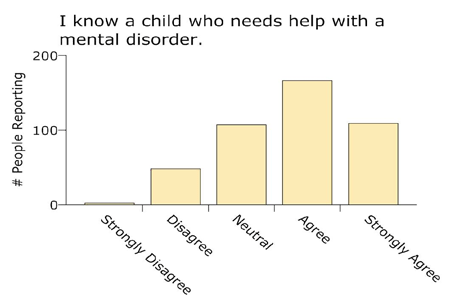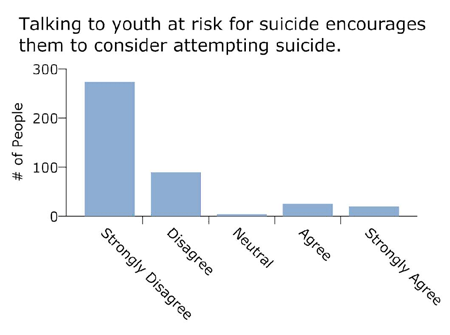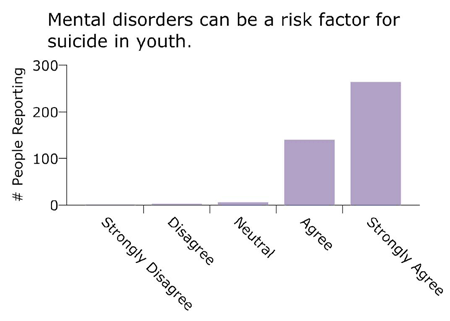Steering Committee Feature Column
Please be sure to visit the Feature Column Archive to read previous columns.
Our Steering Committee Feature Column is updated regularly with information written by and about SAMHSA ADS Center Steering Committee members and their organizations. The SAMHSA ADS Center helps to promote acceptance and social inclusion for people with behavioral health problems and helps to counter the negative beliefs, harmful attitudes, and discrimination experienced by those with behavioral health problems.
We encourage you to share this column with others and to post it in your own newsletters or e-mail lists. For more information, please visit the SAMHSA ADS Center Web site: http://www.promoteacceptance.samhsa.gov.
Please note that the views expressed in this column do not necessarily represent the views, policies, and positions of the Center for Mental Health Services, the Substance Abuse and Mental Health Services Administration, or the U.S. Department of Health and Human Services.
Building Sustainable Suicide Prevention in Idaho with the Awareness to Action Youth Suicide Prevention Project
Ann D. Kirkwood M.A., Beth Hudnall Stamm Ph.D., and Lynda Bennett M.A.
The Idaho Awareness to Action Youth Suicide Prevention Project at Idaho State University’s Institute of Rural Health (AAYSP at ISU-IRH) focuses on building sustainable infrastructure for suicide prevention in the state. ISU-IRH collaborates with partners statewide to achieve lasting changes to reduce the state's high suicide rate among youth ages 10–24 regardless of race or ethnic origin. Idaho ranks in the top 10 states with a suicide rate of more than 19 per 100,000 population in 2009.
Description
The strength of partners is critical to sustainability. Several projects seek to provide partners with the skills needed to operate suicide prevention programs into the future. Below is a sample of the types of activities we have undertaken:
- Creating a cadre of Question, Persuade, Refer (QPR) trainers
- Distributing Signs of Suicide (SOS) kits for student education
- Training audiences statewide using the nationally recognized Idaho’s Better Todays/Better Tomorrows curriculum on signs and symptoms of mental disorders, including trainings for:
- Hispanic youth
- Tribal school staff
- Adult gatekeepers
- Making available a suicide prevention toolkit with an original Idaho public service advertisement campaign
Idaho’s Suicide Prevention Action Network (SPAN Idaho) and National Alliance on Mental Illness (NAMI) affiliates receive National Institute of Mental Health (NIMH) and Substance Abuse and Mental Health Services Administration (SAMHSA) materials and technical assistance concerning the latest scientific information on children’s mental health and suicide prevention. Partners include the Juvenile Justice Administrators, Idaho Federation of Families for Children's Mental Health, SPAN Idaho, NAMI, the Idaho Council on Suicide Prevention and the State Planning Council on Mental Health, as well as county commissioners, 4-H, Girl Scouts, the Military Kids Coalition, National Guard, and Idaho Coroners Association, to name a few.
Methods
Gatekeeper training, coalition-building, and collaboration are highlights of the project, which focuses on a wide range of children’s mental health topics. The mental health focus is based on research that indicates 90 percent of people who die by suicide had mental health/substance use disorders. Customized trainings have been developed for use in schools, primary care facilities, hospital emergency departments, and juvenile justice settings. The customized trainings can be used with Tribal, Hispanic, and parent audiences as well as with audiences concerned with issues related to sexual orientation. ISU-IRH also facilitates the Idaho Council on Suicide Prevention to update and rewrite the state’s suicide prevention plan. Additionally, ISU-IRH conducted a research project designed to guide development of a suicide prevention crisis hotline in Idaho, the only state in the Nation without a certified hotline. Special Awareness to Action Academies are hosted each year to provide training to communities and professionals on social marketing for attitude change, lethality and risk assessment in mental health treatment, and advocacy. The cadre of QPR and Better Todays/Better Tomorrows trainers will be able to carry out suicide prevention and mental health training into the future. Trainings are customized by audience. Participants are given a post-course evaluation. Following the training, participants are anonymously contacted monthly for one year to provide information about the number of youth they have identified as at risk of suicide and the numbers and types of referrals they estimate to have made in the past month.
Results
Registration and Post-Course Evaluation
The data reported here were collected from the Better Todays/Better Tomorrows registration and course attendance conducted between April 2010 and March 2011. Five hundred and forty five people registered in advance or onsite. Of those, 264 people preregistered and attended and 158 people registered at the door, yielding an overall registration to attendance rate of 78%. Although return rate of the post-course assessment varied, the rates were in the 90% range. Figure A shows the types of affiliations of participants. Figures B, C, D, and E show results from key questions from the post-course assessment.
Figure A.

Text description for the above image.
Figure A is a bar chart showing affiliations of 545 people who completed advance registration online. Nearly 150 participants were from juvenile justice professions, 80 were mental health professionals, 70 from higher education, and 90 from schools, kindergarten through twelfth grade. Other affiliations included community stakeholders such as clergy or mental health advocates, military, primary care, tribal services, emergency workers or substance abuse treatment providers.
Figure B.

Text description for the above image.
Figure B is a bar chart showing responses from individuals who participated in Better Todays post-training surveys. When asked if they know a child who needs help with a mental disorder, more than 260 respondents agreed or strongly agreed. Less than 50 respondents said they did not know of such a child.
Figure C.

Text description for the above image.
Figure C is a bar chart showing responses from individuals who participated in Better Todays post-training surveys. Respondents were asked if they are aware of a youth in their community who has attempted or died as a result of suicide. Approximately 325 respondents answered in the affirmative (agree or strongly agree).
Figure D.

Text description for the above image.
Figure D is a bar chart showing responses from individuals who participated in Better Todays post-training surveys. To determine knowledge gain, the surveys posed the following false statement: Talking to youth at risk for suicide encourages them to consider attempting suicide. More than 325 respondents disagreed with this statement, providing the correct response.
Figure E.

Text description for the above image.
Figure E is a bar chart showing responses from individuals who participated in Better Todays post-training surveys. To assess knowledge gain concerning the link between mental illness and suicide, respondents were asked to agree/disagree with the following statement: mental disorders can be a risk factor for suicide in youth. 380 respondents agreed or strongly agreed with this statement. Only a few respondents disagreed or strongly disagreed.
Early Identification and Referral Form
After the Better Todays/Better Tomorrows course was completed, each of the participants was asked to complete the Early Identification Referral Network survey on a monthly basis for one year. Over the 12 months of the survey, we received 97 responses on the question of the number of referrals. (This may be a duplicated count in that each participant is given a chance to respond monthly. We cannot establish an unduplicated count due to the need for confidentiality.) Of the 97 responses, 69 reported that they did not identify a youth at risk for suicide and did not make any referrals. Thirty-three reported that they did not encounter any youth who needed help. Twenty-eight people identified 136 youth at risk for suicide. Of these, 47 were boys, 41 were girls and no sex was reported for 48 referrals. No referrals were made for lesbian, gay, bisexual or transgender youth. The majority of referred youth were white; two youth were Black/African American and two were American Indian. Ten were of Mexican heritage and the remaining youth were of unknown race or ethnicity. Looking across all youth referred, a total of 1,378 referrals were reported: 302 for mental health, 330 for community supports, 294 for academic tutoring, 273 for recreational activities, and 179 for physical health.
This data collection is part of the national cross-site data collection for the Garrett Lee Smith suicide prevention program funded through SAMHSA. The post-training measure and process does not fit well with our program and we do not expect to collect a great deal of data. The EIRF is designed to follow specific youth through a clinical screening and referral process. Our program does not do clinical screenings. Past trainees are given a monthly opportunity to report anonymously how many youth they identified as being at risk for suicide and how many referrals they made. It is very important to note that the potential number of responses is over 400. We have data from 97.
The ISU-IRH project has trained 10,000 adult gatekeepers statewide since 2000 in the nationally recognized Better Todays/Better Tomorrows curriculum. An Awareness Toolkit has been distributed to more than 60 stakeholders to assist them in community outreach and education, including original public service advertisements focusing on youth suicide prevention. Customized trainings have been offered to juvenile justice probation, detention, and clinical staff across the state, and to emergency department directors, coroners, and emergency medical responders. Special programs for schools also have been presented, including a training in rural Burley, ID to 500 school staff at all levels of employment. Suicide prevention advocates are using ISU-IRH research to seek support for creation of a crisis hotline in Idaho, currently ranked in the top 10 states for its rate of suicide. Figure F compares the Idaho and U.S. suicide rates per 100,000 residents from 1997–2008.
Figure F.

Text description for the above image.
Figure F is a line graph showing Idaho and U.S. suicide rates per 100,000 residents from 1997–2008. Idaho’s suicide rate is consistently higher than the national rate. In 2008, Idaho’s overall rate was over 16 per 100,000 population while the national rate was approximately 10 per 100,000. While the national rate has remained almost constant since 1997 at 10–12, Idaho’s rate hit about 18 per 100,000 in 1997, dropped to about 13 in 2000 and has been on an upward trend since that time.
Fourteen individuals are being trained as QPR instructors and a select group of stakeholders also received Applied Suicide Intervention Skills Training (ASIST) training in 2011. Academies on suicide risk assessment, social marketing, and advocacy are offered in each year of the 3-year Garrett Lee Smith Grant. Idaho also collaborates with the State Department of Education and SPAN in developing procedures for postvention in schools, including training for community volunteers to work effectively in schools following a suicide.
Discussion
Advocates statewide seek accurate information and education about suicide prevention and children's mental health concerns. Providing them with evidence-based programs and materials, including NIMH publications, gives them a base of knowledge upon which they can sustain suicide prevention goals. Collaboration and coalition building place the Idaho project at the center of children’s mental health and suicide prevention programs statewide. This capitalizes on ISU-IRH’s role as a lead agency in Idaho as a result of its status as a NIMH Outreach Partner. Virtually no state funds are used for suicide prevention in Idaho. As a recipient of SAMHSA Garrett Lee Smith Memorial Act funding, ISU-IRH provides a unique opportunity for Idaho to continue progress in children’s mental health and suicide prevention. Stakeholder collaboration is rewarding and challenging. While strong advocates mean a sustainable future, stakeholders will work at a speed comfortable to them. As a result, some projects do not follow timelines as submitted in grant proposals. However, this can ensure quality outcomes and stakeholder buy-in.